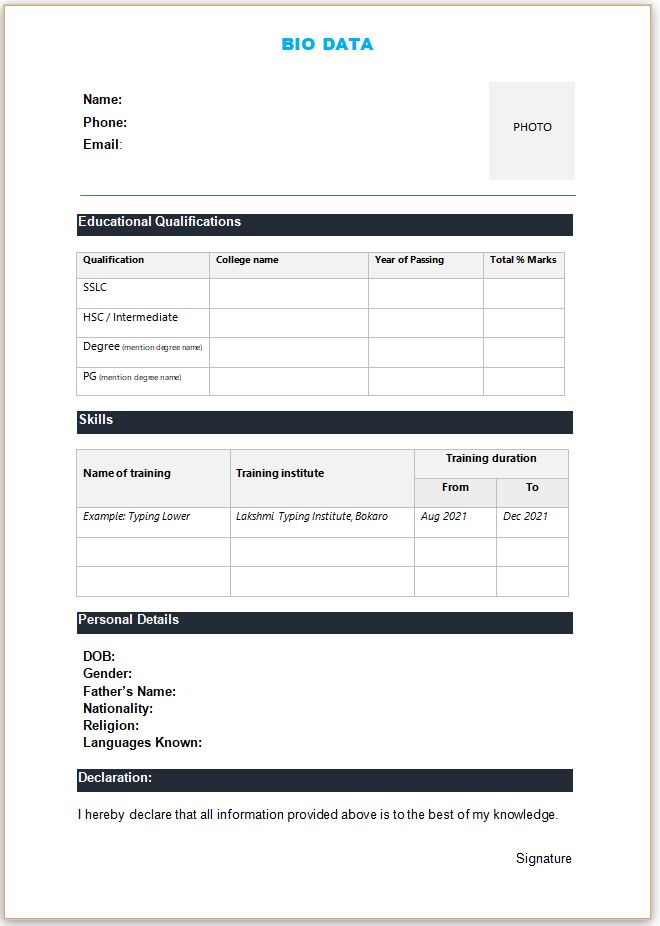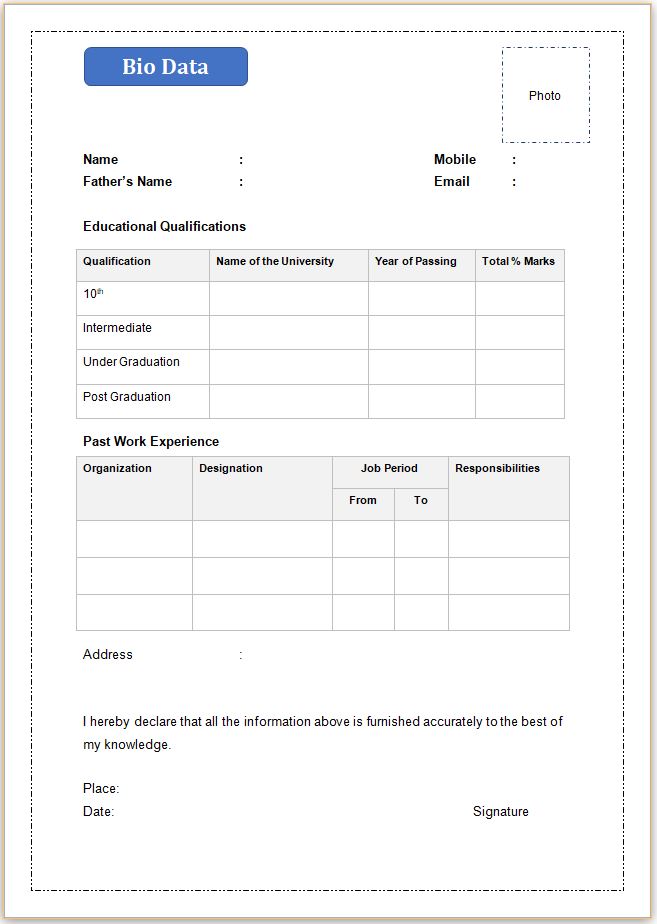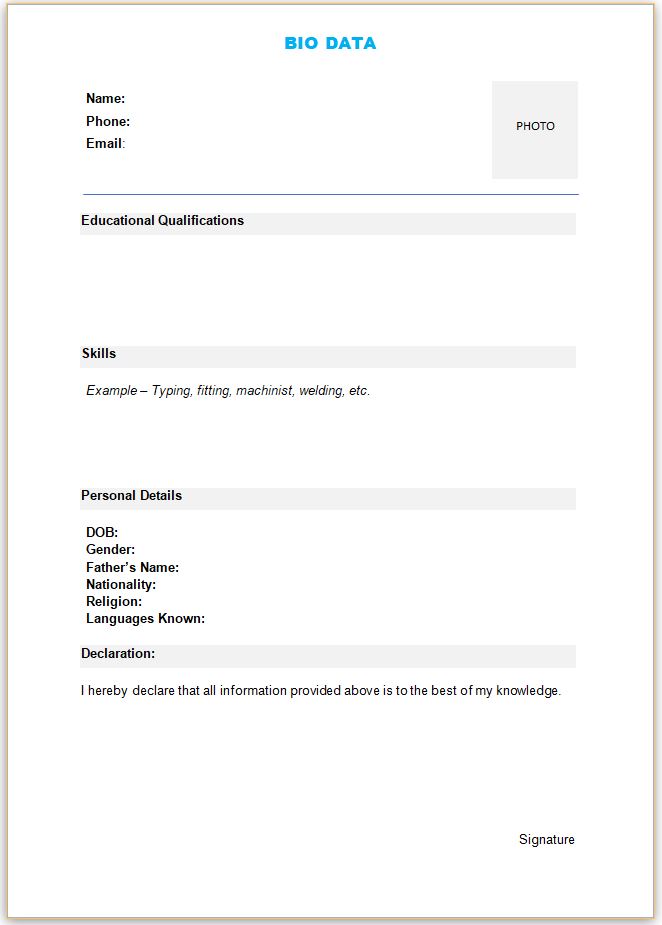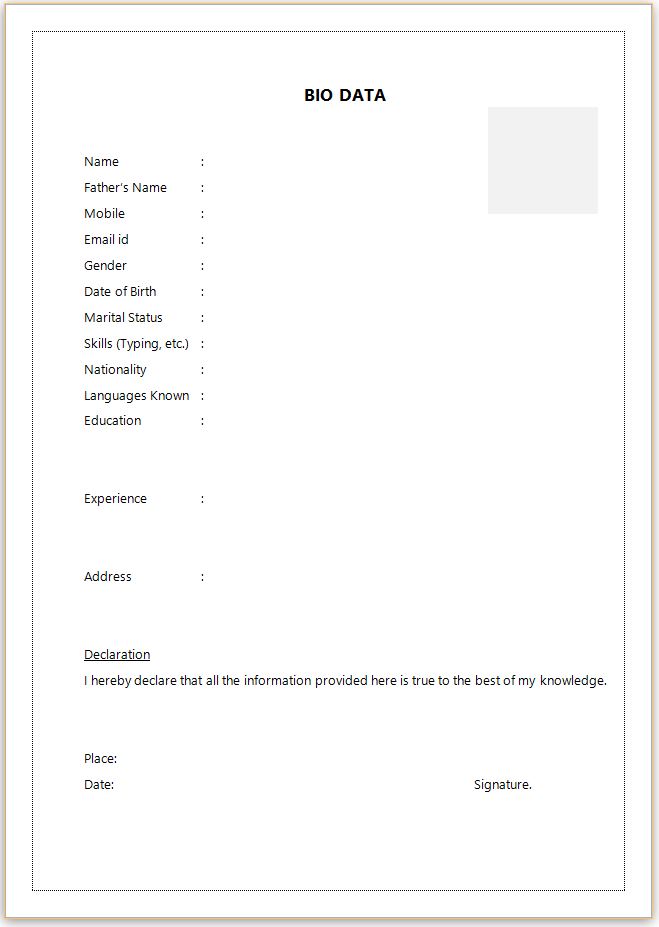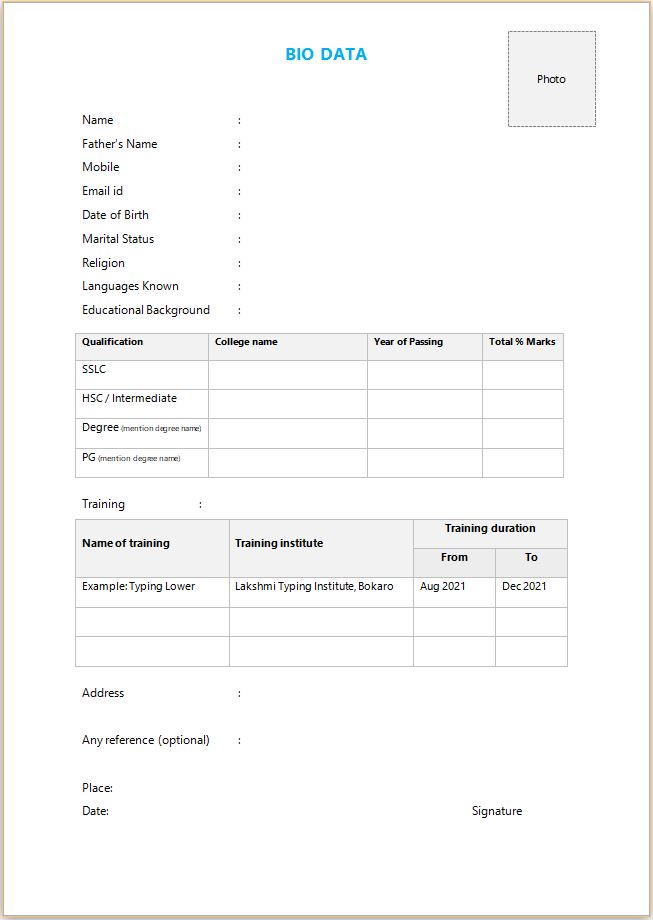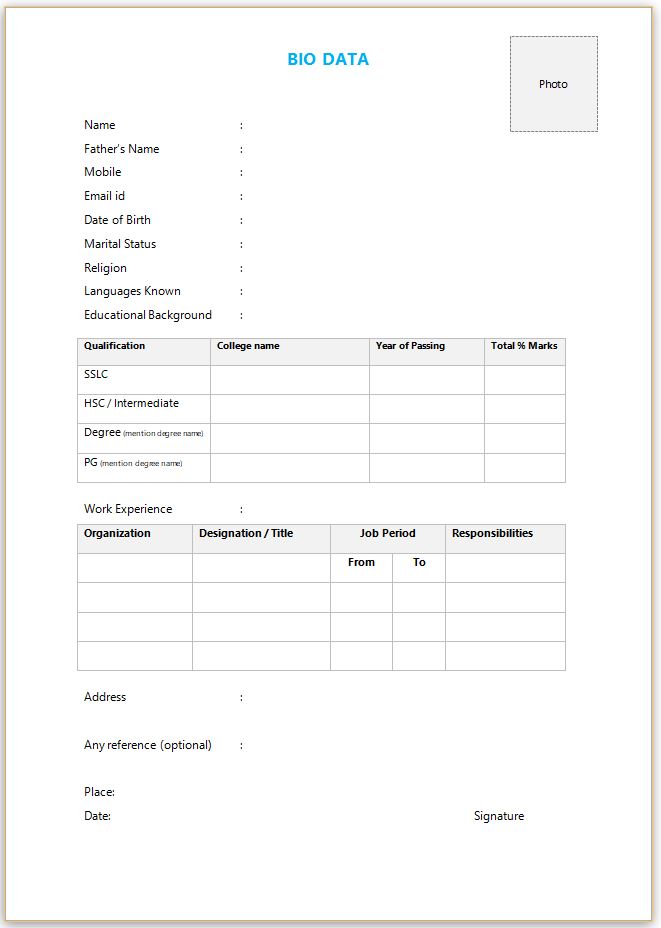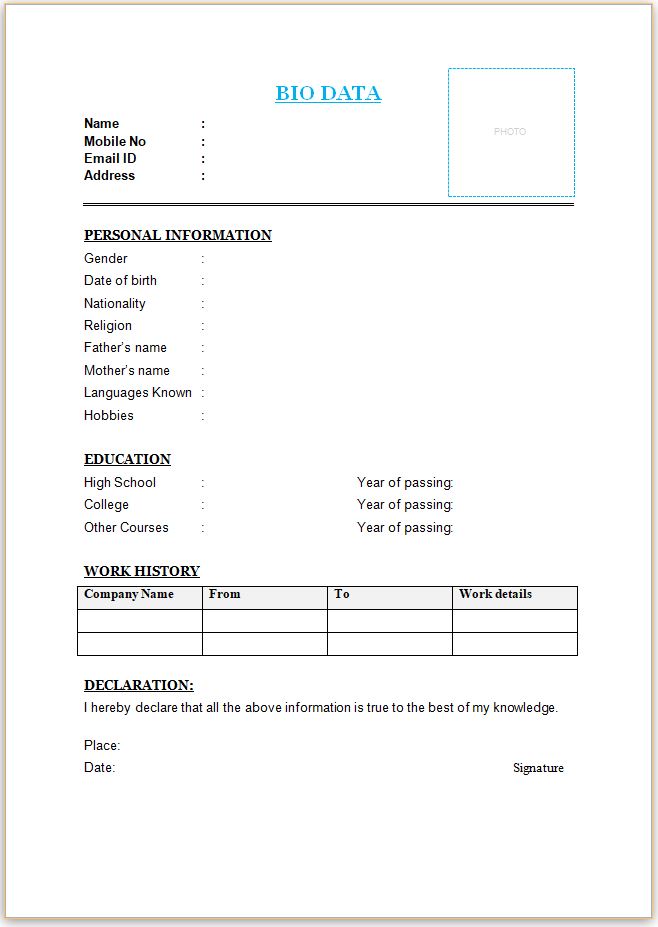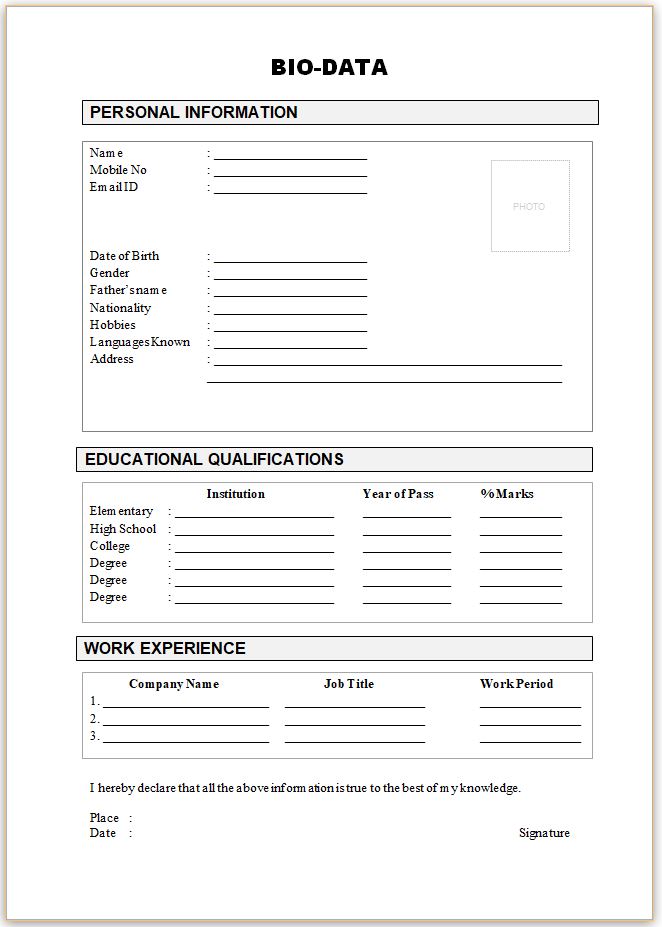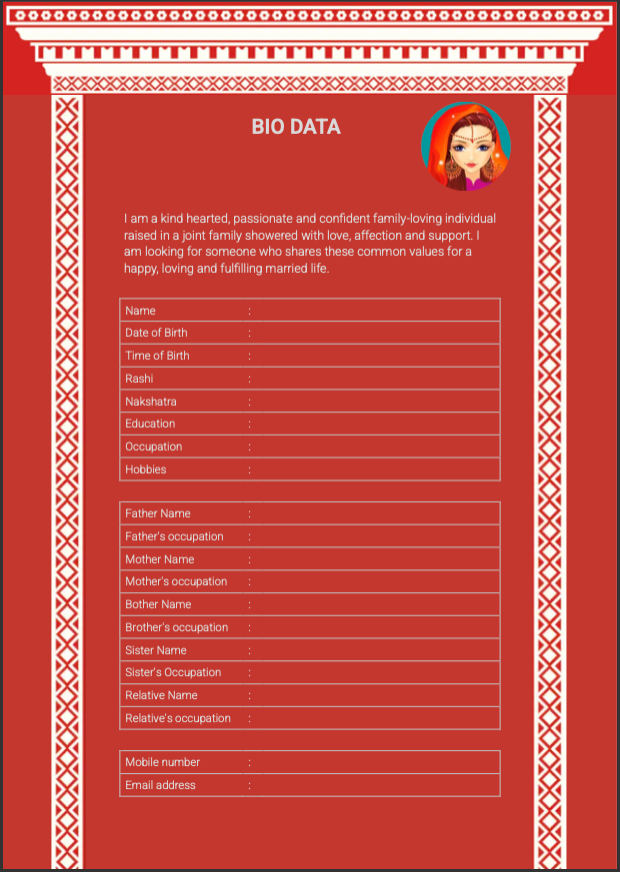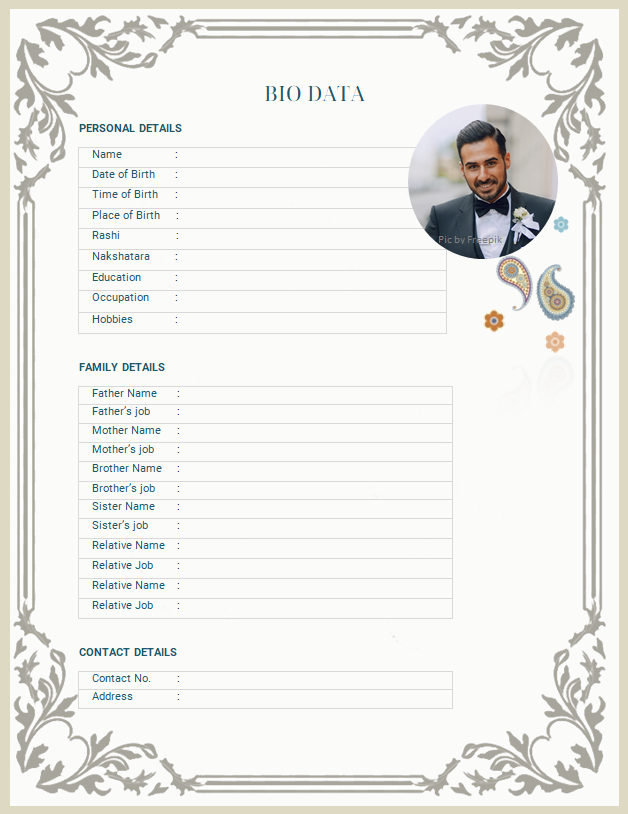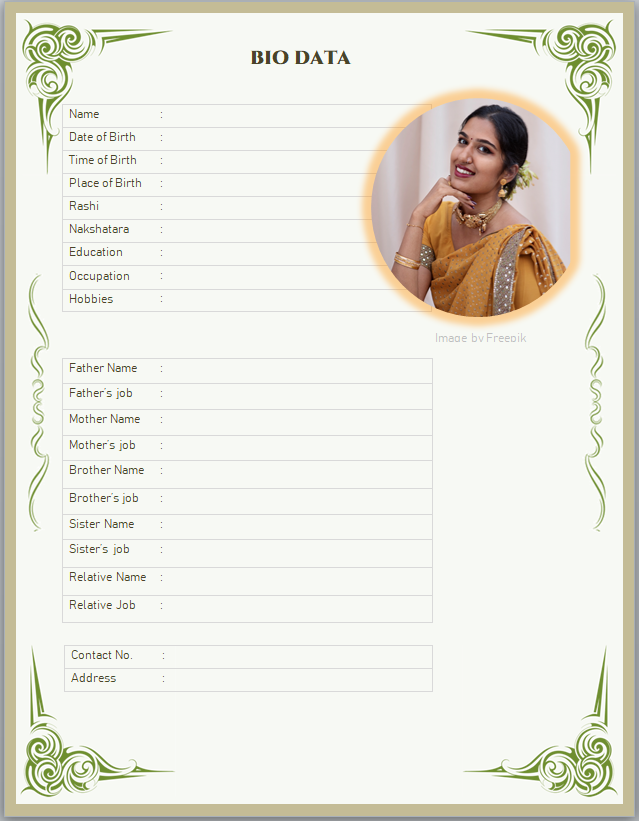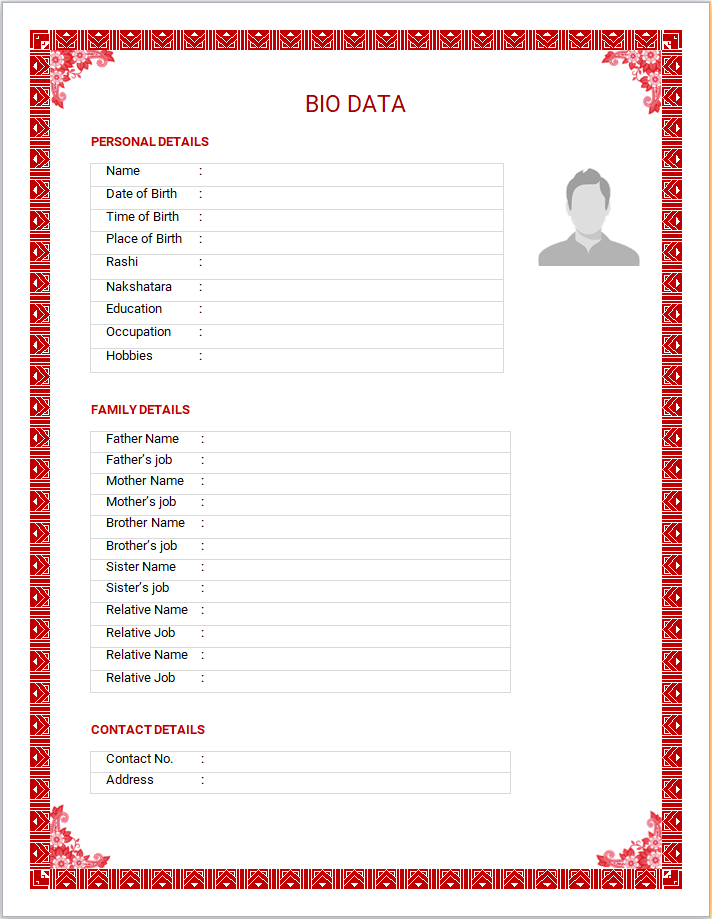Format for bio data in 2024

05 Feb 2024

What is a format for bio data?
A biodata format is a layout of various sections on a word processing software or an application, usually on a website or a mobile app that you can sue to create your bio data from scratch. These bio data formats help you create your bio data in 10 minutes as you complete each section by answering sepcific questions. At the end of the last section, you would have completed your bio data and you can download as a pdf document. In the case of using an MS word template, you can first download the template and update each of the sections on your computer or a mobile device, including phone or a tab / iPad.
In this article on format for bio data, we will cover the following
- What are the various sections in a bio data format
- Mandatory sections in a bio data format
- Optional sections in a bio data format
- 5 Things to be careful about wile creating your bio data
What are the various sections in a format for bio data?
The various sections in a biodata format are as follows
- Personal Details
- Educational qualifications
- Training and Certifications
- Work Experience
- Relevant additional information
1. Personal Details
This is the first section on your bio data. This is an important section and shall not be missed.
The personal details section usually contains details such as your full name, date of birth and contact information.
The full name would mean First Name and Last Name. You can choose to skip your middle name if you don't have one or don't want to include it.
What is a surname?
Sometimes, some bio data templates will refer to last name as Surname. The word surname is usally british style and if your template has surname, it just means you have to put down your last name. Similarly, some bio data templates will have "Given Name". Given Name is just another name for First Name. So, if you downloaded a bio data format from somewhere and it has "Given name", all it means is "First Name."
Some bio data formats will have a field for Full Name, instead of First Name and Last Name. In these cases, you simply write your full name in one stretch. For example, if you name is Ravi Kumar Shastri, you will write "Ravi" for First Name and "Shastri" in the field for Last Name. Or, if the bio data format has just one field for name, you will write "Ravi Kumar Shastri" or "Ravi Shastri".
As for the date for birth, it is better to wrtie full forms of your date of birth. For example, if your date of birth is 11 January 2001, it is better not to write 11/1/2001 because some can misunderstand this to be Novermbr 1st 2001 since in some countries the date format has month in front of the date. So, to avoid any confusion, you should choose to write the full date of birth by writing full month.
How to include contact information on format for bio data
If you do not have an email address and if the format for bio data you are using has email address field, you can simply put N/A. N/A means "Not applicatble". This would indicate to the one who is reviewing your bio data that you simply do not have an email address and that is absolutely fine and you don't have to worry.
Everyone these days has a mobile phone and a mobile number. You should include at least some phone number on your format for bio data so the employer or whoever it is your are submitting your bio data to could get in touch with you if needed.
If you do not have a personal mobile number, it is okay to update the format for bio data with your friend's or anyone else's mobile number instead and inform them to let you know if someone calls for you.
You can also include a landline number if you don't want to include a mobile number. Just make sure that someone would answer the landline if someone calls that number. It could be your neighbour's or your distant relative's. As long as someone answers the phone, it is absolutely fine to include any phone number.
Educational Qualifications on format for bio data
This is the place to list all your educational qualifications, usually starting from 10th standard.
The majority of the formats for bio data would already have a table with placeholders for where to enter each of your educational details. Most format for bio data will also include % marks scored in each exam, where you studied and when did you study. Try and do your best to update your educational qualifications as accurately as possible.
If the format for bio data has rows in the education section for qualifications you do not have, do not worry. You can simply fill up the rows for which you have information and ignore the rest of the rows. For example, if you have completed a Diploma in Mechanical Engineering and the format for bio data has a row for degree, you can simply strike out the degree and instead use it to furnish your Diploma in Mechanical Engineering details.
Expert bio data tip!
It is okay to not provide an email address.
But, you should provide at least a mobile number or a landline number so the recruiter could get in touch with you.
Training and Certifications on format for bio data
This is the section to list down all training and certifications you have. Include all training and certifications even if you do not have the certificates for whatever reason. Not all trainings result in a certificate being awarded so not assume that you should not include them.
How to show training on your bio data
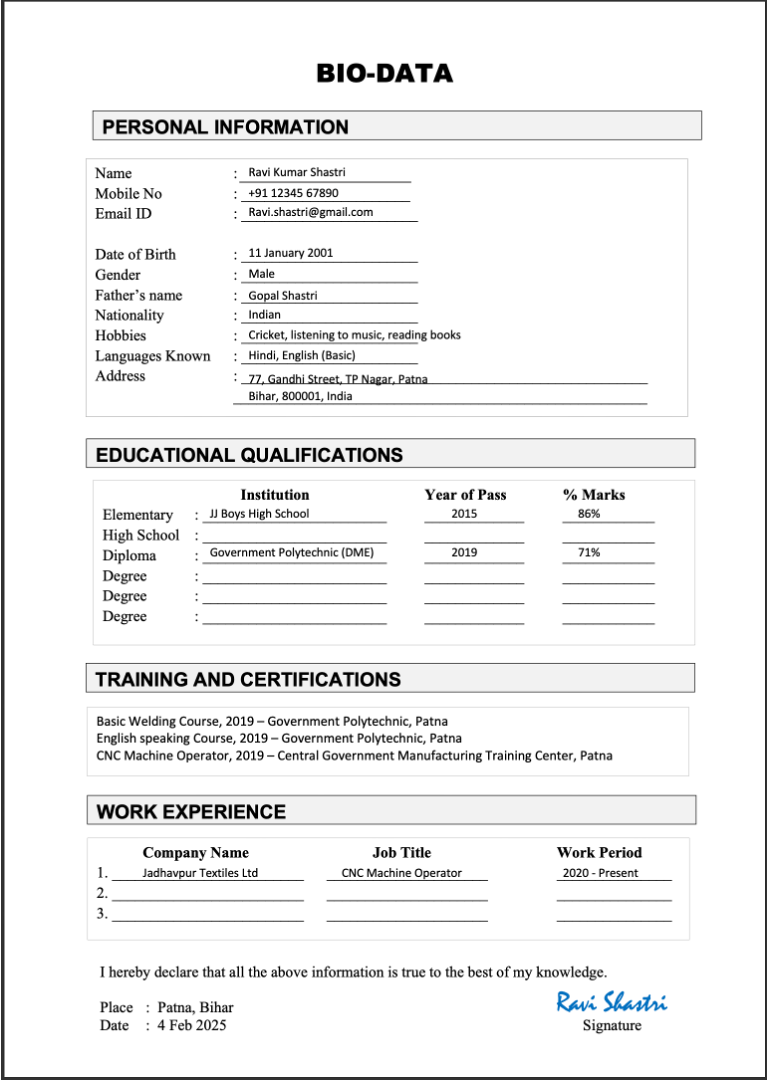
If the point on your training ever comes up on your interviews, you can always mention that whoever conducted the training did not provide you with a certificate and the interviewer would understand. The same goes for certificates as well. If you attended a certication course but somehow did not complete it and obtain the certification, you should still mention the certification on your biodata and explain it during the interview. Do not assume that you should not include your certification related training if you did not get the certificate.
Expert bio data tip!
It is okay to list a training even if you don't have the certificate.
As long as you genuinely attended the training, it is perfectly fine to include the training in your bio data even if you did not obtain the certification for whatever reason.
Also keep in mind that there is no point in including irrelevant training you may have attended when you were in school. If you finished a Diploma in Electrical Engineering and looking for an Electrical Technician work using your bio data, it is better to include training relevant to that profession and there is no point in including a First Aid training you attended in school in your 6th grade.
Free format for bio data to download in MS Word and Edit
How to include Work Experience on Format for bio data
Arguably, this is one of the most important sections in your bio data if you have any work experience.
Some tips for including work experience on your bio dataWhen including work experiences on a biodata, you want to provide concise and relevant information. Here are five tips to help you present your work experiences effectively:
Chronological Order:
Arrange your work experiences in chronological order, starting with the most recent. This makes it easy for readers to follow your career progression.
Include Key Details:
For each work experience, mention the job title, the name of the company or organization, the duration of employment, and the location. This provides a quick overview of your professional background.
Highlight Achievements:
Focus on your accomplishments and contributions in each role. Instead of just listing job duties, emphasize the impact you made. Quantify achievements whenever possible, using numbers or percentages.
Relevance to the Position:
Tailor your work experiences to match the requirements of the position you're applying for. Highlight experiences and skills that are directly relevant to the job you're seeking.
Use Action Verbs:
If your format for bio data you are using has space for including responsibilities, list down your work experiences as bullet points. Start each bullet point describing your work responsibilities with strong action verbs. This makes your biodata more dynamic and engaging. For example, use verbs like "implemented," "managed," or "developed."
Relevant additional information on bio data
One thing that you should consider including on your bio data is hobbies and interests. If you are really passionate about any hobby, it makes a lot of sense in including them to show your personal side to the recruiters.
Benefits of including hobbies and interests on bio data
While a bio data primarily focuses on your professional qualifications, incorporating a section for hobbies and interests can offer several advantages:
Showcasing Personality:Hobbies reveal aspects of your personality and interests outside the workplace, providing a more holistic view to those reviewing your biodata.
Building Connections:Shared hobbies can create common ground during interviews or networking opportunities, fostering connections with potential employers or colleagues.
Demonstrating Skills:Certain hobbies may highlight valuable skills. For instance, being part of a sports team showcases teamwork, while creative pursuits like painting or writing demonstrate artistic abilities.
Indicating Work-Life Balance:Including hobbies suggests a healthy work-life balance, emphasizing that you have interests beyond your professional responsibilities.
Memorability:Unique hobbies can make your biodata more memorable. It adds a personal touch and helps you stand out in the minds of those reviewing numerous profiles.
While including hobbies, be selective and consider the relevance to the job you're applying for. Tailoring this section can enhance its impact and contribute positively to your overall biodata.
Best Hobbies and Interests to Put on Your Bio Data
When selecting hobbies to include in your biodata, aim for a well-rounded representation of your interests. Consider hobbies that reflect various aspects of your personality, skills, and values. Here's a list of 10 hobbies to inspire you:
Reading:Showcase your love for literature and continuous learning.
Photography:Highlight your creativity and attention to detail.
Team Sports - Cricket, Hockey, etc.:Demonstrate your teamwork and leadership skills.
Gardening:Reflect on patience, dedication, and nurturing qualities.
Traveling:Illustrate your curiosity and openness to new experiences.
Volunteering:Showcase your commitment to social causes and community service.
Cooking or Rangoli:Highlight your creativity and ability to handle tasks with precision.
Playing a Musical Instrument:Express your passion for the arts and discipline.
Fitness Activities:Emphasize your dedication to health and well-being.
Projects:Demonstrate your hands-on skills and resourcefulness.
Keep in mind that the key is to choose hobbies that align with your genuine interests and values. Tailor the list to showcase a diverse range of activities that collectively paint a vivid picture of who you are beyond your professional life.
If your bio data is already one page long and don't have space to include hobbies, it is perfectly fine to avoid including hobbies.
5 Things to Be Careful About While Creating Your Bio Data
Creating an effective biodata involves more than just listing your details. It's a representation of yourself that can leave a lasting impression. While it is important to provide all the relevant information as accurately as possible, you should also keep in mind these important factors to be safe as you do not know whose hands your bio data falls into and how they would use your personal information.
Do not include passport detailsIt is a common mistake we see these days in bio data formats we come across. Do not include your passport details such as number, date of expiry etc. or any detail of any government issued id. These id can include your driving license number or your aadhar card or PAN card. Do not share this information on your bio data at any cost.
Photo is optionalAlthough a lot of formats for bio data these days have a place to paste your photograph, you do not need to attach your photograph to the bio data unless your employer or the person you are submitting your bio data has requested you to add your photograph. Remember you are getting hired for what you can offer using your skills and anuone forcing you to add your photograph should also explain to you why your picture is necesary om your bio data.
Do not share OTP or passwordsIn relation to your bio data, if anyone requests you to share your mobile OTP or passwords for email accounts or your mobile phone, do not share them at any cost. These are most certainly fradulent attempts and no employer would ever ask your for a mobile OTP or password for your email accounts. Be safe and do not share any of this information.
Professional Tone:Maintain a professional tone throughout your biodata. Even if it includes personal interests or hobbies, present them in a way that complements your overall image. Strive for a balance between professionalism and personal touch.
Consistency:Check for consistency in formatting, font styles, and overall presentation. A well-organized and consistent biodata reflects attention to detail and professionalism. It also makes it visually appealing and easy to read.
By paying attention to these aspects, you can ensure that your biodata is not only accurate but also lets you in peace that you have not compromised the security of your personal information.
